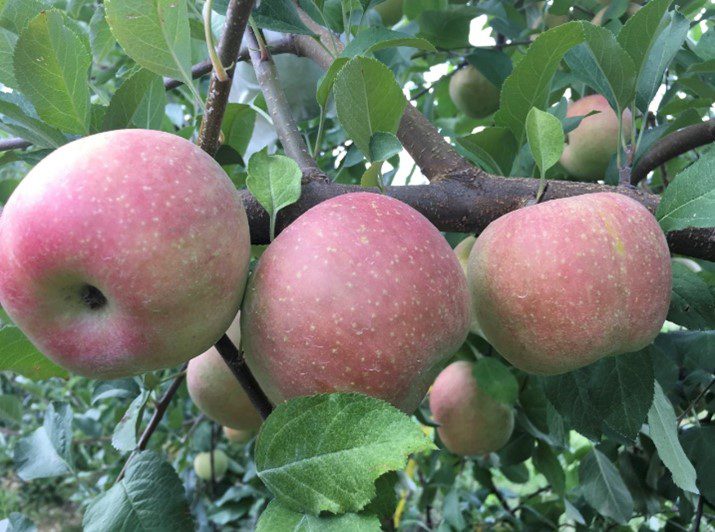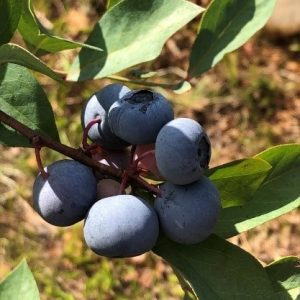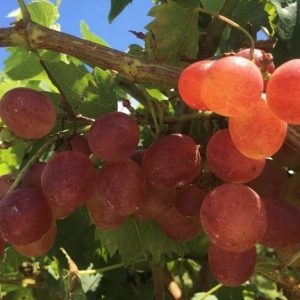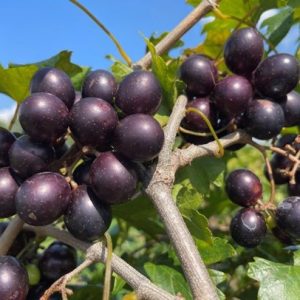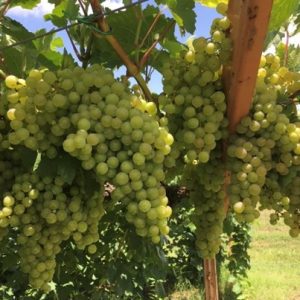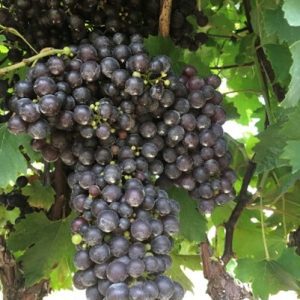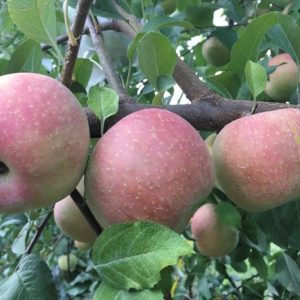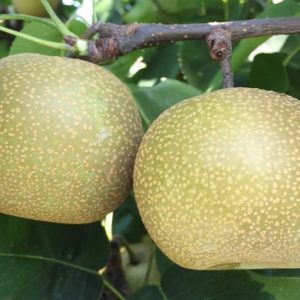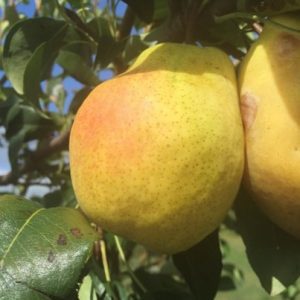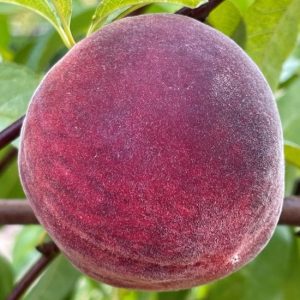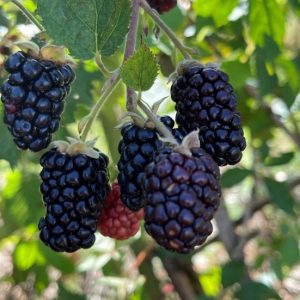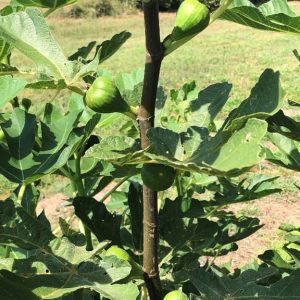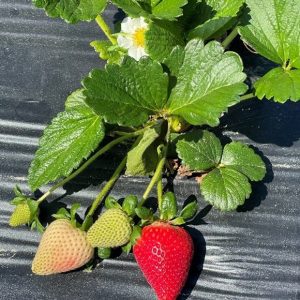Crop Production

Understanding the various subgroups of fruit crops, based on factors such as botanical and horticultural differences, makes it easier for producers to choose suitable varieties.
Many fruit crops can be divided into different subgroupings based on botanical, horticultural, or other differences, such as flowering and fruiting characteristics. If prospective producers understand these different groupings within a fruit crop, selecting appropriate varieties within subgroups will become much easier.
By establishing several fruit crops, growers can have a continuous supply of fruit during the spring, summer, and fall months. For example, strawberries can be harvested from March to June, followed by blackberries from May to June, peaches from May to September, grapes from July to September, and apples from July to October. The normal harvest periods for most fruit grown in Alabama are shown in table 1. The table indicates when harvest begins in the southernmost part of the state and when it concludes in the northern sections of the state. Thus, a given fruit may be available in the state for 2 to 4 months but only in a particular area for 3 to 6 weeks. Most of the minor fruit crops are grown mainly for home use.
Figure 1. Several fruits are popular among homeowners and can be successfully grown throughout the state:
- Figure 1a. Blueberry
- Figure 1b. ‘Victoria Red’ hybrid bunch grape
- Figure 1c. Muscadine
- Figure 1d. Pierce’s disease–resistant predominantly Vitus vinifera grape
- Figure 1e. Vitus vinifera grape Pierce’s disease resistant
- Figure 1f. ‘Aztec Fugi’ apple
- Figure 1g. Asian pear
- Figure 1h. European pear
- Figure 1i. Peach
- Figure 1j. Blackberry
- Figure 1k. Fig
- Figure 1l. Strawberry
Table 1. Fruit Harvest in Alabama
| Fruit Crop | Harvest |
|---|---|
| Strawberry | Harvest begins in mid March and ends in early June. Harvested, refrigerated strawberries available to the public early to mid June. |
| Peach | Harvest begins in late April and ends in early September. Harvested, refrigerated peaches available to the public throughout September. |
| Nectarine | Harvest begins in late April and ends in early September. Harvested refrigerated nectarines available to the public throughout September. |
| Plum, Green | Harvest begins at the beginning of May and ends in early June. Harvested refrigerated green plums available to the public early to mid-June. |
| Blackberry | Harvest begins at the beginning of May and lasts through July. Harvested refrigerated blackberries may be available to the public until mid-August. |
| Plum | Harvest begins at the beginning of June and ends at the end of July. Harvested refrigerated plums may be available to the public from the beginning of August until early September. |
| Blueberry, Highbush | Harvest begins at the beginning of June and ends by early July. A dotted line indicates that harvested refrigerated highbush blueberries may be available to the public until the end of July. |
| Blueberry, Rabbiteye | Harvest begins in early June and ends in late August. Harvested refrigerated rabbiteye blueberries may be available to the public until mid-September. |
| Raspberry | Harvest begins in early June and ends in early July. Harvested refrigerated raspberries may be available to the public until early September. |
| Green Apple | Harvest begins in mid-June and ends in early July. Harvested refrigerated green apples may be available to the public until mid-July. |
| Cherry, Sour | Harvest begins mid-June and ends early July. Harvested refrigerated sour cherries may be available to the public until the end of July. |
| Bunch Grape | Harvest begins mid-June and ends late August. Harvested refrigerated bunch grapes may be available to the public until mid-September. |
| Asian Pear | Harvest begins early July and ends mid-August. Harvested refrigerated Asian pear may be available to the public from mid-August until mid-September. |
| Fig | Harvest begins in early July and ends in late September. Harvested refrigerated figs may be available to the public in early October. |
| Summer Apple | Harvest begins mid-July and ends early August. Harvested refrigerated summer apples may be available to the public from mid-August until mid-September. |
| Pear, Soft Type | Harvest begins late July and ends early September. Harvested refrigerated soft pear may be available to the public from early September until early October. |
| Feijoa and Pomegranate | Harvest begins at the beginning of August and ends at the beginning of October. Harvested refrigerated feijoa and pomegranate may be available to the public from early October to mid-October. |
| Pear, Hard Type | Harvest begins at the beginning of August and ends at the end of September. Harvested refrigerated hard pears may be available to the public throughout October. |
| Quince | Harvest begins early August and ends late September. Harvested refrigerated quince may be available to the public from late September until mid-October. |
| Muscadine Grape | Harvest begins early August and ends late September. Harvested refrigerated muscadine grapes may be available to the public from early to mid-October. |
| Fall Apple | Harvest begins early August and ends early October. Harvested refrigerated fall apples may be available to the public from mid-October until the end of December. |
| Kumquat | Harvest begins mid-September and ends mid-November. Harvested refrigerated kumquats may be available to the public from mid-November until mid-December. |
| Satsuma | Harvest begins late September and ends in early December. Harvested refrigerated Satsuma mandarin may be available to the public from early to mid-December. |
| Oriental Persimmon | Harvest begins early October and ends late October. Harvested refrigerated Oriental persimmons may be available to the public from early to late November. |
| Kiwifruit | Harvest begins in early October and ends in early November. Harvested refrigerated kiwifruit may be available to the public until the end of December. |
Table 2. Characteristics of Different Fruit Crops
2 Vitus vinifera grapes are not the grape of choice since they are susceptible to a vascular disease called Pierce’s Disease.
| Fruit Crop | Subgroup | Description |
|---|---|---|
| Tree Fruit1 | ||
| Apple | Reproductive growth habit: nonspur and spur | Nonspur trees refer to the normal, larger mature trees found in many older orchards. They require 4 to 6 years to begin cropping. Spur-type trees are slow growing and begin developing spurs and producing fruit at only 2 to 3 years of age. They may be planted at closer spacing and will remain smaller than nonspur trees. |
| Skin color: red, green, and yellow | Red, green, or yellow skin color occurs on varieties of both spur and nonspur trees. | |
| Pear | Reproductive growth habit: spur and nonspur | Although some spur-type trees (as described above for apples) may exist, none are generally available to commercial or home fruit producers. All common varieties are the larger nonspur type. |
| Flesh characteristics: soft and firm; susceptible to fire blight | European-type pears and their Oriental hybrids can be subdivided into soft and firm flesh types. The standard European pears, such as Bartlett, have soft fruit with a sweet, buttery-like texture, but trees are usually highly susceptible to fire blight. Pears more commonly grown in the southeast are the European x Oriental hybrids, such as Orient, usually referred to as hard pears. They have very firm fruit with many stone cells in the flesh, which give them a gritty texture and limit their use mainly to processing. However, the hard pears are much more tolerant of fire blight. | |
| Asian Pear | Source of origin: Japanese or Chinese (different fruit shapes and variable skin color) | Japanese types are generally round and similar in shape to apples. Chinese types are typically pyriform in shape like European pears. Within each of the two subtypes, varieties may have smooth skin (green to yellow in color) or russetted skin (green to brown in color). |
| Quince | Horticultural characteristics: ornamental or fruiting type | There are basically two types of quince: the small, bush-like, very early flowering plants used as ornamentals and the larger tree form of fruiting quince. Orange is the primary variety of fruiting quince grown. Plant characteristics are somewhat like the apple and pear, but fruit are quite hard and normally used only for processing into jellies and jams. |
| Peach, Nectarine | Fruit shape: round to oblong or flat | Standard peaches have the normal peach shape while peento subtypes are flat and saucer-like in shape. Not many peento varieties are grown, but new ones are being introduced. |
| Type of flesh: melting or nonmelting | Peach subtypes may have melting flesh, which is the soft flesh of most fresh varieties, or nonmelting flesh, which is typical of the rubbery clings used in canning. | |
| Flesh color: yellow or white | Peach subtypes may have yellow or white flesh. | |
| Stone freeness: cling or freestone | Peach subtypes may have cling (flesh adheres to pit) or freestone characteristics, although many varieties are somewhat in between a full cling or freestone. | |
| Plum | Source of origin: Japanese, European, or American | Many plum varieties grown today resulted from crosses of two or all three common subtypes available. |
| Type of flesh: soft, sweet dessert-type (Japanese and American) or very firm, prune-type (European) | The standard varieties produced in western states for fresh markets are usually referred to as Japanese dessert-type fruit, which are quite tasty and have several skin and flesh colors. Most southeastern varieties are similar but have more American germ plasm in them to instill more disease resistance. They usually consist of crosses of two or three subtypes. European (plum-type) plums have very firm flesh and are mainly used for making prunes or as processing fruit rather than for eating fresh. | |
| Cherry | Fresh flavor: acid or sweet | Cherries can be divided into varieties with sour flesh used for processing or sweet flesh used mainly for fresh consumption. A third category has been developed by crossing sweet and sour types and is referred to as Duke cherries, which are mainly used for processing. |
| Other horticultural characteristics | Sour types are very self-fruitful, and sweet types are highly self-unfruitful. Because of early flowering habits and crop loss to freezes, sweet cherries are not recommended in Alabama. Where sweet cherries are grown, special attention must be given to arrangement of varieties to ensure cropping. | |
| Persimmon | Source of origin: American or Asian | American persimmon fruit are not very flavorful, and the primary use of the American persimmon tree is for timber. The large, tasty persimmons found in supermarkets are of Asian origin and are commonly referred to as “Oriental” or “Japanese” persimmons. |
| Flesh tannin level: astringent or nonastringent | Oriental or Japanese persimmons can be divided into nonastringent, which are low in tannins and can be eaten before fully ripe (such as the Fuyu variety), and astringent, which must be fully ripened (usually off the tree) to avoid a disagreeable bitter taste. | |
| Pollination needs | Some are self-fruitful, and others need cross pollination. Varieties may be strongly or weakly self-fruitful and produce fruits with or without seeds. | |
| Pomegranate | Horticultural application: either as ornamental plant or for fruit production | Many varieties of pomegranates are grown as ornamentals and usually fruit rather poorly. Other varieties have been specifically bred for superior fruit production. |
| Fig | Flowering and fruiting characteristics: production of seedless fruits, which require no pollination of seeded fruits, which require pollination | There are basically three types of figs: common, Smyrna, and San Pedro. Common types, which produce seedless fruits, are grown in the southeast. Smyrna types, which produce seeded fruits are grown in California. To produce fruits, they require a special type of cross-pollination (called caprification) by special insects found only in that area. These insects transfer pollen from male plants to Smyrna-type varieties. San Pedro types produce both types of fruit described above. |
| Small Fruit | ||
| Grape2 | Source of origin: European and American | Fresh grapes grown in California are of European origin, mostly the Vitis vinifera type that produce large fruit clusters. Fresh and processing grapes grown in the eastern United States are mostly V. labrusca (American) and V. rotundifolia (muscadine). Both are native to America. A number of European (French) x American hybrids are also being grown for juice, wine, and fresh use. |
| Type of fruit cluster produced: bunch grapes or muscadines | Bunch grapes, which include varieties of Vitis labrusca and V. vinifera, produce large fruit clusters. Muscadines produce small clusters. | |
| Blackberry | Erectness of canes: erect and trailing subtypes | Blackberries are easily classified into those having rigid, erect canes and those having trailing canes, which require trellises to keep plants above ground. Home gardeners may grow either type, but commercial growers prefer varieties with erect canes for ease of management and highest net income. Erect blackberries should be trellised. |
| Thorniness: thorny and thornless canes | Traditionally, few thornless varieties had been available and all were trailing types. Growers have generally preferred the erect, thorny types for maximum income per acre. However, erect, thornless varieties have gained in popularity. | |
| Primocane fruiting | Primocane fruiting plants may provide a late summer/early fall crop. Summer heat may lower the quality of the primocane fruit. Most blackberries fruit on second-year canes called floricanes. Primocane blackberries fruit on the first-year canes (primocanes) and also fruit on second-year floricanes. | |
| Raspberry | Time of fruiting: spring or fall | All raspberry selections can be classified into types that produce fruit in the spring only or in the spring and fall. |
| Fruit color | Raspberries can be divided into groups that produce either black, purple, or red fruit. | |
| Blueberry | Species and growth habit | Blueberries commonly used in home and commercial plantings are classified into highbush and rabbiteye types. Highbush usually grow 6 to 8 feet tall, and rabbiteye may grow 10 to 15 feet tall or taller if not pruned. All three types are different species of Vaccinium. The latest type of blueberry introduced is the southern highbush, which is a hybrid of several cultivated and wild species. |
| Chilling requirement and fruiting habit | Rabbiteye varieties have low chilling requirements and are usually self-incompatible, requiring cross-pollination. Highbush varieties are generally more self-fruitful and have very high chilling requirements. Some recent varieties referred to as southern highbush types combine the low-chilling rabbiteye characteristics with the more cold-hardy, earlier-fruiting northern highbush attributes. | |
| Strawberry | Photoperiodic nature (how plants react to day length) | There are three subgroupings of strawberries based on their photoperiodic nature: spring-bearing, everbearing, and day neutrals. Strawberry varieties commonly produced commercially and in home gardens in the southeast are spring-bearing. (These may be referred to as short-day varieties.) These selections flower, fruit, and produce runners in that order. Everbearing varieties flower and fruit in the spring but then initiate flower buds under longer summer days. The two crops (spring and fall) produced by this type have been poor in quality and yield in the southeast. Day-neutral selections flower, fruit, and produce runners at the same time. They tend to produce a normal spring crop and a rather small fall crop. To date, varieties of this type have not proven superior to spring-bearing selections. |
| Subtropical and Exotic Fruit | ||
| Satsuma | No subgrouping of satsumas | Satsumas are mandarin-type fruits that are the most cold hardy of the sweet, low-acid-type citrus grown commercially. |
| Fruit characteristics and time of harvest: small differences among varieties | Owari is the primary variety grown and produces high-quality fruits. Armstrong Early matures its fruit 3 to 4 weeks ahead of Owari. It tends to have smaller fruit and is not as high in quality, although very acceptable. | |
| Kumquat | Fruit characteristics: fruit shape and flavor based on species | Kumquats are the most cold hardy of the acid-type citrus that produce edible fruits. Three Fortunella species comprise the most common varieties grown. Varieties can be divided into those that produce oblong (Nagami) or round (Meiwa and Marumi) fruit. Varieties are also divided into those producing sweet (Meiwa) or semisweet/tart fruit (Nagami and Marumi). |
| Kiwifruit | Fruiting characteristics: based on species | The standard kiwifruit of the industry is Actinidia deliciosa. Hayward is the most common female variety. This type produces large, tasty fruit with fuzzy skin. Actinidia arguta, the “cold-hardy kiwi,” produces very small fruit about grape size that are smooth (no fuzzy skin) and very sweet. Both species are dioecious, having male and female varieties. |
| Cold hardiness: based on species | Hayward is the only moderately cold hardy kiwifruit. It is especially sensitive to freeze damage through 3 years of age. There are cold-hardy relatives of kiwifruit, such as Actinidia arguta, called “cold-hardy kiwi,” that may have promise for home and commercial production. Plants of A. arguta have resumed spring growth before A. deliciosa some years. More evaluation of these promising kiwifruit relatives is needed. | |
| Feijoa | Fruit characteristics: fruiting and ornamental types | Feijoas have been bred to develop varieties with superior fruiting characteristics. The two varieties commonly used in Alabama, Mammoth and Triumph, are capable of producing large, high-quality fruit; however, they often produce small fruit not acceptable on the commercial market. Reportedly, fruit size increases substantially when Collidge is used as a pollinator with these varieties. The pineapple guava is the ornamental version of feijoa that generally produces low yields of poor-quality fruit. |
By considering your location, crop adaptation, and soil type, you can design your orchard for successful production for years to come.
 Elina Coneva, Extension Specialist, Professor, Horticulture; William East, Regional Extension Agent, Commercial Horticulture; Edgar Vinson, Assistant Extension Professor, Horticulture; and David Lawrence, Regional Extension Agent, Commercial Horticulture, all with Auburn University. Originally prepared by Arlie Powell, former Extension Horticulturist; David Himelrick, former Extension Horticulturist; William Dozier, former Extension Specialist; and Mary Beth Musgrove, former Extension Associate, all in Horticulture with Auburn University.
Elina Coneva, Extension Specialist, Professor, Horticulture; William East, Regional Extension Agent, Commercial Horticulture; Edgar Vinson, Assistant Extension Professor, Horticulture; and David Lawrence, Regional Extension Agent, Commercial Horticulture, all with Auburn University. Originally prepared by Arlie Powell, former Extension Horticulturist; David Himelrick, former Extension Horticulturist; William Dozier, former Extension Specialist; and Mary Beth Musgrove, former Extension Associate, all in Horticulture with Auburn University.
Revised March 2024, Fruit Culture in Alabama: Fruit Crops to Grow in Alabama, ANR-0053-B

